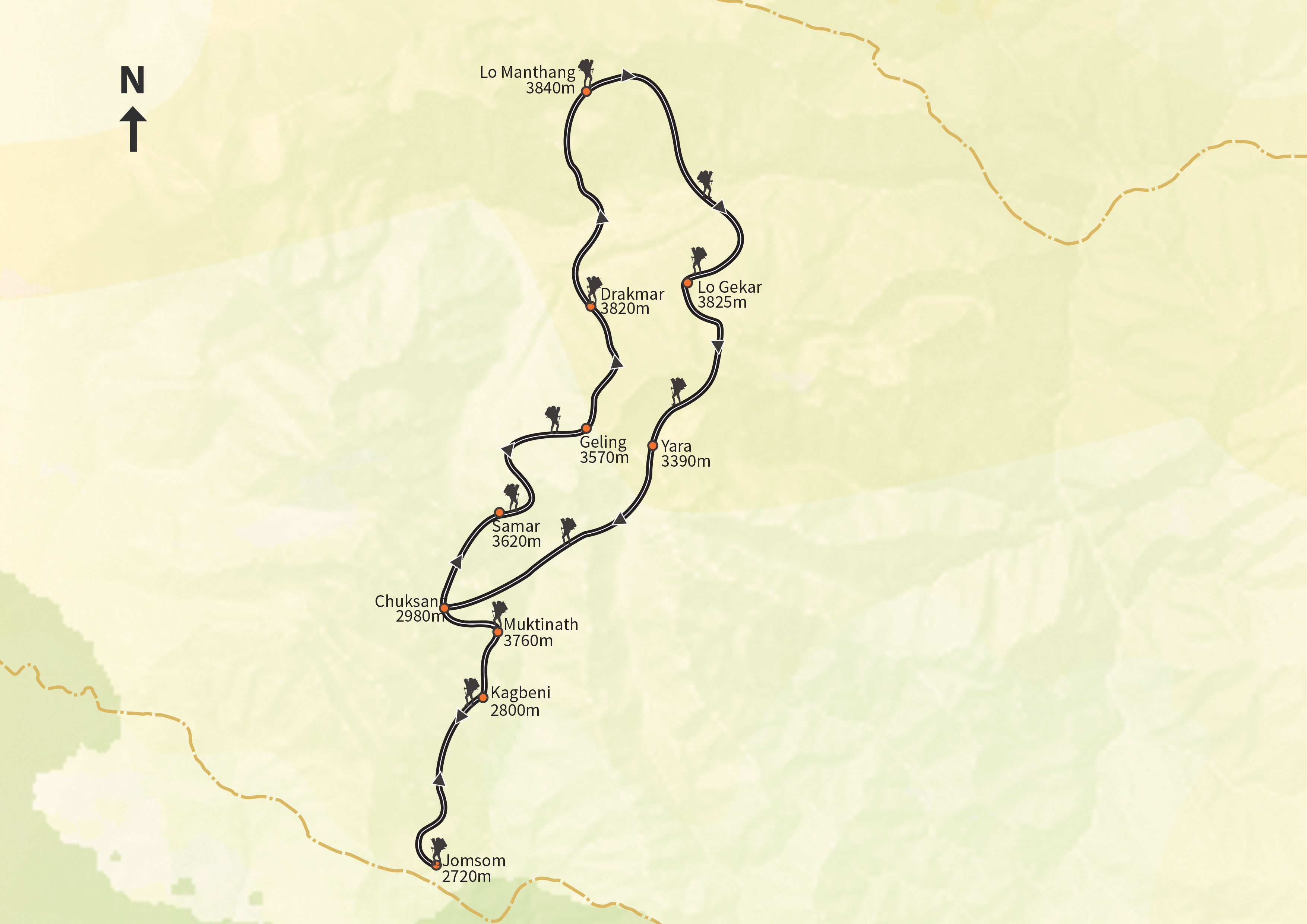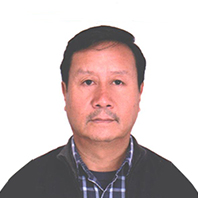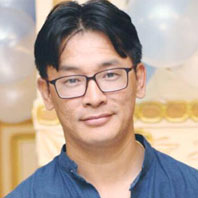
Lo-Manthang trek
Eight of the world's tallest mountains and the world's oldest Hindu and Buddhist pilgrimage sites are located in Nepal. Nepal offers unparalleled adventure options with abundance in flora and fauna. Although modernization has set in, the essence of ancient Nepal – warm hospitality still remains in heart of every Nepalese.
Mustang is located in the heartland of Nepal, alongside the border with Tibet. During the trek, you can witness rugged barren mountains, deep canyons, eroded cliffs and Moraine valleys, snow-capped peaks and more.
Trip Highlights
- Visit UNESCO World Heritage Sites in Kathmandu.
- Visit Muktinath temple – a sacred pilgrim site for both Hindu and Buddhist.
- Visit Kali Gandaki Valley – the world’s deepest river gorge
Detailed Itinerary
Day 1: Arrival in Kathmandu (1,350m)
Depending on your arrival time, our representative will be at the airport to receive you and transfer you to your booked hotel.Evening dinner at the Hotel.
Meals: D
Day 2: Kathmandu: Sightseeing and trek Preparation
Today after the breakfast we’ll be touring around the Kathmandu valley. The Durbar Square, Swoyambhunath Stupa, Pashupatinath temple and Boudhanath Stupa are the major sight-seeing areas around the Kathmandu valley. These all are listed in a world heritage sites. The Durbar square shows us the regal life of ancient periods. Pashupatinath temple is one of the most scared Hindu pilgrimages. Swoyambhunath temple and Boudhanath stupa is the Buddhist temple which is very popular around the globe. Swoyambhunath is also known as money temple stands on the hilltop west of the Kathmandu valley. It can also be known as the view point of Kathmandu valley. Boudhanath temple is the biggest Chorten ever made around the world. Later on, after the sight-seeing we will introduce to our fellow participants and discuss our trip preparations.Meals: B
Day 3: Fly to Pokhara
Today we will fly to Pokhara a short scenic 25 minutes flight. On arrival at Pokhara airport we are transferred to Hotel. Remaining afternoon at leisure or stroll around Lakeside.Meals: B
Day 4: Fly to Jomsom(2720m) & Trek to Kagbeni(2800m). Approx. 3.5 hrs walk
Early morning we will fly to Jomsom which takes approx. 20 minutes having close views of Annapurna Range, Dhaulagiri and others. Upon landing at the airport, we will meet with our crew members and head out for Kagbeni. It takes about 3.5 hrs walk to reach Kagbeni from Jomsom. On reaching the Kagbeni Village, we will complete our paperwork at police check post before entering this long forbidden region of Nepal.Meals: BLD
Day 5: Trek to Chuksang (2980m). Approx. 5 hrs walk
Today we will head out for Chuksang. The trail passes through the mix of high trail and riverbank with the endless stretch of sand to the village of Tangbe. The village is a labyrinth of narrow alleys, fields of buckwheat and barley and apple orchards with the view of Nilgiri Peak on the back. After 2 hrs hike, we will reach Chuksang village which lies at the confluence of the Narshing Khola (River) and Kali Gandaki River.Meals: BLD
Day 6: Trek to Samar (3620m). Approx. 4-5 hrs walk
Today we will hike to Samar passing through a small settlement known as Chele village. During the walk, you can find a distinct change in topography, culture, lifestyle, and people. From Chele, we will climb a steep spur to Taklam La (3624m) and Dajong La (3660m). After crossing these two passes, you will descend on a pleasant trail to Samar.Meals: BLD
Day 7: Trek to Geling (3570m). Approx. 5 hrs walk
From Samar, we climbto a ridge and then descend into a large gorge past a Chorten. We then pass through the Ranchug cave, one of the holiest places in Mustang. We then cross a stream, climb a pass and then descend along a ridge to Shyangmochen. From there the trail climbs gently to Geling.Meals: BLD
Day 8: Trek to Drakmar (3820m). Approx. 5-6hrs walk
From Geling, we head west, climbing gently through fields to Tama Gaun. Then we head north to reach Nyi La (4020m). We then descend down from the pass and after 30 minutes’ walk, we come to a trail junction from where we head straight to Dakmar Village.Meals: BLD
Day 9: Trek to Lo Manthang (3840m) via Lo Gekar (3825m). Approx. 7-8hrs walk
After early breakfast, we head out for a long day walk to Lo Manthang. We will pass through Lo Gekar and Ghar Gumba (Monastery) which is one of the major attraction of the day.Meals: BLD
Day 10: Acclimatization day in Lo Manthang
Explore the fascinating city of Lo Manthang. Today we will visit the four major temples Namgyal Gompa (situated on the hilltop and also used as a local court), Champa Lakhang (God House), Thugchen Gompa and Chyodi Gompa.Other attraction is the king's palace an imposing building in the center of the city and is occupied by the current King and Queen.
Meals: BLD
Day 11: Trek to Yara (3390 m). Approx. 6-7 hrs walk
We begin our return journey from Lo Manthang,to Yara passing by Sungden Chorten.The trail then gently climbs on the ridge viewing the scenic landscapes. After an hour steep descend we again come to a wide highland and descend rocky gully and knee crunching trail until reaching Dhi village. We cross by a suspension bridge over the Kaligandaki River and make a short steep climb following PuyungKho lato Yara village.Meals: BLD
Day 12: Day visit to Luri Gompa and back to Yara village
Today is the rest day at Yara village to explore the surroundings. We take a day trip to Luri Gompa (Monastery) which is considered as one of the mighty holistic place.Meals: BLD
Day 13: Trek to Tangye (3240m). Approx. 6-7 hrs walk
We set out early for a long day walk to Tangye village. The trail first goes through short but steep ascend and becomes long flat way before stepping down to Dechhyang Khola. Afterwards the trail goes up and down and then we are on a huge plateau crossing it to reach Tangya village.Meals: BLD
Day 14: Trek to Chuksang (2920m)
Today will along descend to Chuksang which takes approx. 8 hrs walk. We start off early leaving the village and crossing a suspension bridge, following a short river route. We then cross the river and steeply climb up passing small passes along the way we reach the hill top. Further, descend down until reaching the village of Chuksang.Meals: BLD
Day 15: Trek to Muktinath (3760 m). Approx. 6-7 hrs walk
Today we descend down to Muktinath which takes approx. 6 hrs walk. We descend down through the Tetang village. After a steep climb, we come to a view point from where we can have a panoramic view of Mt. Dhaulagiri, Annapurna and Tukuche Himalayan range. Then we descend down crossing a small stream by a suspension bridge to the village of Chhyongar. We then follow the level trail until reaching Muktinath.Meals: BLD
Day 16: Trek to Jomsom [2710m]
Today we leave Muktinath and descend down to Jharkot village where we visit the ancient Sakyamuni Buddhist Monastery and Traditional Medical Center and then to Ekalbhatte and to Jomsom.Meals: BLD
Day 17: Fly to Kathmandu via Pokhara
We take an early morning spectacular flight from Jomsom to Pokhara and catch a connecting flight back to Kathmandu.Meals: B
Day 18: In Kathmandu
Day at leisure.Meals: B
Day 19: Final departure
Depending on your flight time you will be transferred to the airport. The airport checks in is 3 hours prior to the departure time and the hotel checkout time is 12 PM. In case our flight is late evening please let us know if you require half day use of the hotel.Our representative will meet you at the hotel and transfer you to the airport.
Meals: B
Essential Info
Visa
Most nationalities require a visa for Nepal, which can be obtained in advance or on entry. If you wish to apply before departure the current visa cost is £20 for a 15 day visa and £35 for a 30 day visa for UK passport holders. The current cost of a visa on arrival is US $25 for 15 days, US $40 for 30 days or if extending your stay $100 for 90 days. All are multiple entry. The visa on arrival fee can be paid for in cash in US Dollars, Pounds Sterling or Euros. You will also need a passport photo. Application forms are available in the immigration hall (or for electronic passports there are visa registration machines which, after inserting your passport, automatically fill out a form for you). You must firstly join the queue to pay the visa fee, and then go to the relevant immigration desk to obtain your 15, 30 or 90 day visa stamp. There can be long queues for visas on arrival.Non UK nationals should check requirements with their nearest embassy (a few nationalities are not permitted visas on arrival).
Vaccinations
There are no mandatory vaccination requirements. Recommended vaccinations are: Polio, Tetanus, Diphtheria, Typhoid, Hepatitis A. The risk of malaria is present in certain regions only (such as Chitwan); you may wish to consult your GP or travel health clinic for further advice. Dengue fever is a known risk in places visited. It is a tropical viral disease spread by daytime biting mosquitoes. There is currently no vaccine or prophylaxis available for Dengue, and therefore the best form of prevention is to avoid being bitten. We recommend you take the usual precautions to avoid mosquito bites. Most of our trips to Nepal go to high altitudes where there is a risk of being affected by Acute Mountain Sickness. Our itineraries are designed to enable everyone to acclimatise to these altitudes, but you should be aware that it is still possible for you to be affected. Please refer to the TRIP NOTES for complete advice on AMS.Eating & Drinking
Breakfast is included throughout the trip and all meals are provided while camping (all breakfasts, 3 lunches and 2 dinners).Breakfast is included throughout the trip and all meals are provided while camping. On trek the breakfast will be a set menu usually consisting of porridge and toast. Any additional items that are not included in the set menu should be ordered and paid for separately. We do not include lunch and dinner in the tea-houses, allowing you to choose what you want to eat and when. Although most lodges have almost identical menus, they are reasonably extensive and offer a varied selection, ranging from traditional Nepalese dal bhat to pizza and apple pie.
Although meat is available in the tea houses, we advise against eating it on trek. The meat has often been carried in the heat from lower altitudes for several days before reaching the lodges, and can cause stomach upsets or illness. Germs can also be spread by handling dirty money - we recommend using hand sanitiser.
If you buy imported food and drink whilst on trek you will spend more than the suggested amount.
Drinking Water
Staying hydrated is important when undertaking any physical activity but particularly so at altitude where it is generally recommended to drink at least 3-4 litres per person per day.
We strongly encourage you not to buy bottled water on trek as this contributes to the growing problem of plastic pollution in Nepal’s trekking areas.
All tea houses will provide cold water free of charge, if requested. Although this should not be drunk untreated, we recommend that you bring a reusable bottle with a wide opening (Nalgene or similar) with you and use a SteriPEN to treat it with. A SteriPEN is a handheld UV water purifier – small, lightweight and battery powered so easy to pack for a trek. In Nepal’s trekking regions most of the bottled water isn’t strictly ‘mineral water’ anyway but is UV treated, so it’s exactly the same technology. It’s quick to use, far more effective than purification tablets, and the water is ready immediately. It’s fine to use a SteriPEN on non-boiled water so long as it isn’t cloudy or full of sediment (which is uncommon in these regions).
SteriPENs are widely stocked on Amazon, outdoor shops and other online retailers; look for the latest models but avoid USB charging ones. Better still, a SteriPEN will pay for itself over the course of the trek and you won’t leave behind a single plastic bottle – you will end up spending the same or even less than you would on bottled water, plus you can keep it for future trips.
If you prefer not to invest in a SteriPEN, the tea houses also sell boiled water for approx. Rs150-300 per litre (the price increases the higher you trek) which should not require treating. This is also perfect for a bedtime refill as it can double up as a hot water bottle.
While camping boiled water is supplied for drinking.
Weather
The main trekking season in Nepal is from October to mid-May when daytime temperatures at most altitudes are generally comfortable for walking, the sky is clear much of the time and rain and snow are occasional occurrences. Daytime temperatures will vary from 15ºC to 35ºC in the Kathmandu Valley to around 10ºC at 3,600m and progressively lower the higher we go.Different seasons offer different advantages for trekking.
Post Monsoon/autumn: Mid-September to November. This is the main trekking season in Nepal. Day temperatures in Kathmandu are approximately above 20ºC. Skies are usually clear and days on trek are sunny and mild with clear mountain views. At the highest altitudes although the days can be nice and sunny the temperatures can drop to 10ºC and much lower. Nights will be colder with temperatures dropping as low as minus 10ºC and lower at the highest altitudes.
Pre-monsoon/spring: March to May. Both day and night temperatures will be warmer in general but haze will often build up in the afternoons. It is very hot in the lowlands and temperatures rise to 35ºC in Kathmandu. Flowers bloom in this season and this is one of the reasons people chose to trek in spring.
Snow can be expected on any departure, usually at the higher altitudes. Summit day will be a very early start (usually about 2am) and will be extremely cold. Although mostly it is calm and clear on summit day the mountain does occasionally get high winds. You need to be equipped for temperatures as low as minus 25ºC plus wind chill on summit day.
Please remember that in any mountain area the weather is never wholly predictable and you should be prepared and equipped to deal with any differences in weather beyond the conditions described above.
More Info
This is a Tough+ trek. It is activity level 9 with 16 days walking and full porterage throughout. The maximum altitude is 6,189m (or 5,545m without Island Peak) and the average is 3,680m. There are some steep ascents and descents and some narrow trails. As this trek also ascends to very high altitudes participants should be confident of their physical fitness and must have previous experience of trekking at altitude and in snow.Although it is not compulsory to participate in the climb (the summit attempt is optional), anyone who does must have previous ice axe and crampon experience and know how to use a jumar and abseil device. There will be equipment checks and practice sessions for rope use, ice axe, crampon and harness use, abseiling and crevasse rescue. For safety reasons it is compulsory to participate in these sessions. If you do not take part the leader and climbing Sherpas will not allow you to take part in the climb.
Though technically harder than Mera Peak, for those with the necessary experience this expedition is within the reach of those seeking their first Himalayan summit. The climb requires strong lungs and a great deal of will power - it is graded alpine PD+ and starts with some rocky scrambling to a glacier. We cross the glacier roped up (there is one ladder to cross), and then come to a 200m steep 40-45 degree headwall, which leads to a 20m summit ridge. We will rope up to cross the glacier and you will be walking with an ice axe, crampons and plastic boots. There are fixed ropes up the headwall (approximately 200m) and along the summit ridge. On the ascent you will need to use a jumar and on the descent you will need to use an abseil device.
Please be aware that altitude can have a significant affect on your physical state. It is important that you take heed of the leader's advice and decisions at all times. The leaders are trained in first aid and are well aware of AMS symptoms and will keep a close eye on the group. We ask you to refer to the altitude warning within the Trip Notes.
The climb itself is not recommended for anyone with a fear of heights or vertigo and the main trail itself crosses three modern suspension bridges over rivers and valleys - all of these have mesh sides but some are quite long and high.
Equipment Checklist
Our Specialist
How to Book
We like to offer a personalized service to our clients – you can contact us by email or telephone any time. Please let us know if you wish to chat with us via Skype, Whatsapp or Viber and we can connect with you at a time that is suitable for you and us, depending on where you are in the world and the timezone you are in.
Check availability:
Go online to check availability, or contact us by phone or email.
Secure your place
You can provisionally hold a place on this trip, usually for between three and seven days.
To Book
Let us know which trip you would like to join. For trips that require a certain level of skills and prior experience, we will ask you to provide us with details so that we know the trip is the right one for you.We will send you a form for you to complete your personal details, medical and fitness information. We will also send you our bank details for you to make payment – we will tell you how much and how to pay.
When you are ready, simply complete the form and send it back to us and let us know once you have deposited the relevant funds into our bank account.
We will send you back a written acknowledgement and other information about your trip such as a gear list and any other relevant information specific to your trip.
Of course, at any time leading up to your trip, if you have any questions, please do not hesitate to contact us as we will want to give you as much information as you need so that you can feel comfortable and excited about your forthcoming adventure.
We look forward to having you on an adventure with us!




